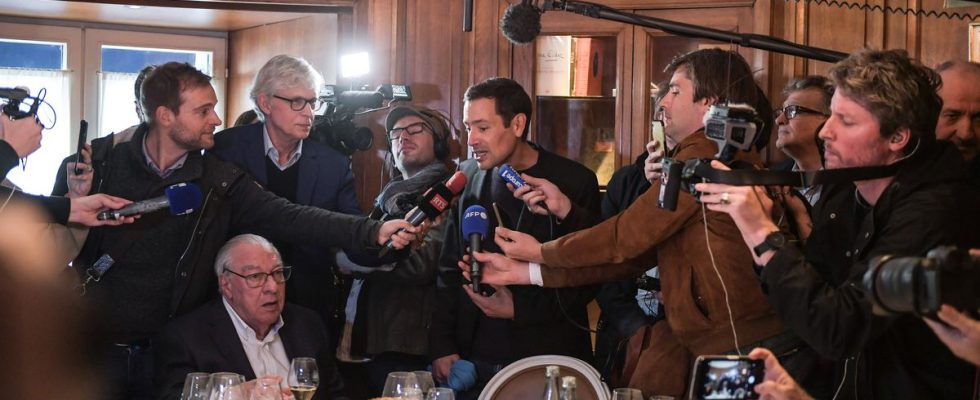The Goncourt Prize was awarded Tuesday to Jean-Baptiste Andrea for Watch over her (editions L’Iconoclaste), a love story during the time of fascism in Italy, already rewarded with the Fnac prize. Every year, the announcement of the most prestigious literary prize in France provokes excitement among journalists, cameramen and photographers gathered at the Drouant restaurant in Paris. The photojournalist Isa Harsin regularly covers this event for the agency Sipa Press. Through the making of an image of the winning writer responding to the press just after the announcement of the results, she reveals to 20 minutes some little secrets to take the right photo.
What do we see in the image?
“It’s an image of euphoria and excitement around Jean-Baptiste Andrea, the star of the day,” explains Isa Harsin to 20 minutes. There, the winner does not look at the photographers, he is in his world with the journalists to describe what he feels and talk about his book. » For the photographer, the framing of the image is “wide enough to see everything that is happening around it”. We also see Didier Decoin, the president of the jury, seated, “waiting quietly”. Isa Harsin explains that she wanted an image of the table with Dider Decoin during the interview with the writer because it is “the photo that represents Goncourt”. While confiding: “Last year I didn’t have it, and then I said to myself: “I have to have it!” »
What is the shooting context?
Isa Harsin emphasizes 20 minutes : “Le Goncourt is a legendary price in a legendary place”, namely the Drouant restaurant in the 2nd arrondissement of Paris. “What I’m looking for is to have all the footage of the award ceremony. There are a lot of us and there are a lot of cameras. » She says that once the name is known, you have to be outside to see the arrival of the winner. Then, there are two options: “Either we go straight into the restaurant knowing that the television cameras have priority, or we wait outside because there is always the photo sequence in the window. There, I tried the lunch room, telling myself that I would sneak in and go after the cameras. » And once at the top, the photographer adds: “We try to have an overall scene while being quick because once the interviews are finished, we have to go back down to also have the winner showing himself at the window. » On the hardware side, the journalist tells us that she has two bodies, one equipped with a 24-70 mm lens and the other with a 70-200 mm, allowing her to have a wide range of angles from the widest or more tight according to the plane value that it wants to attribute to the image. Here she uses the first option.
The extra anecdote
Evoking the euphoria and the group of journalists on the lookout, Isa Harsin specifies: “There is absolutely no assigned place. We can rush around a little but generally things go well. » She explains that all the photographers know each other more or less and that they try to work “on good terms”. A friendly atmosphere which generally allows everyone to take the photo they want. “We do the same job and we also have to know how to share a little, knowing that we all have a different eye,” she adds. The photographer spends a lot of time waiting and you have to know how to be patient. And this wait allows Isa Harsin to “identify the places and find the small place when there are people”. However, she cautions against falling into a form of ease when photographing a subject often. The photojournalist always tries to look for new angles but specifies that it helps to know “the places and the light”.
Regarding the presence of women in photojournalism, “I have been in the field for more than ten years now and things are going really well. Even if it remains masculine, there are more and more sisters and men accept it rather well. Then, we all have different sensitivities. » And added: “And there is a succession with young women”, quoting Jeanne Accorsini or Gabrielle Cézard, also from the Sipa Press agency.

